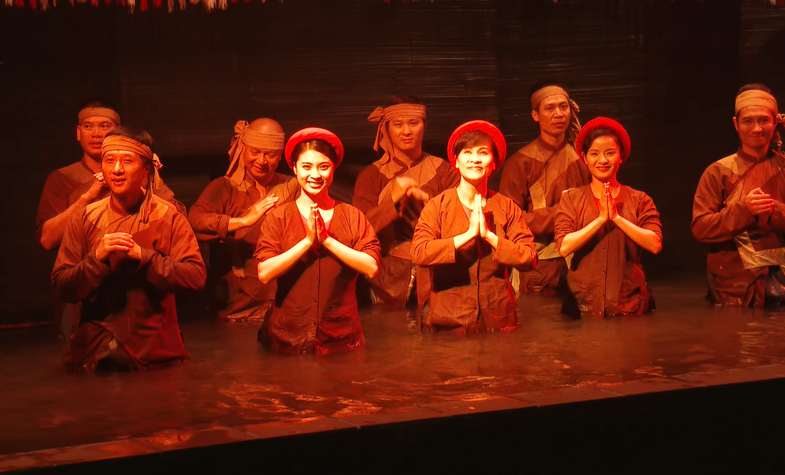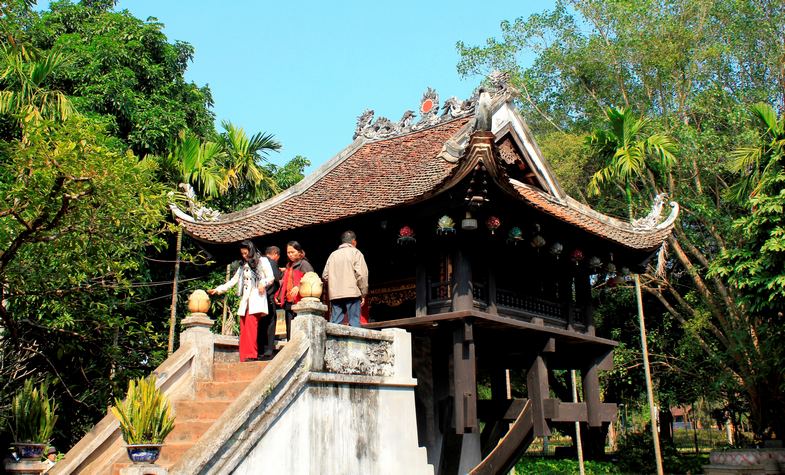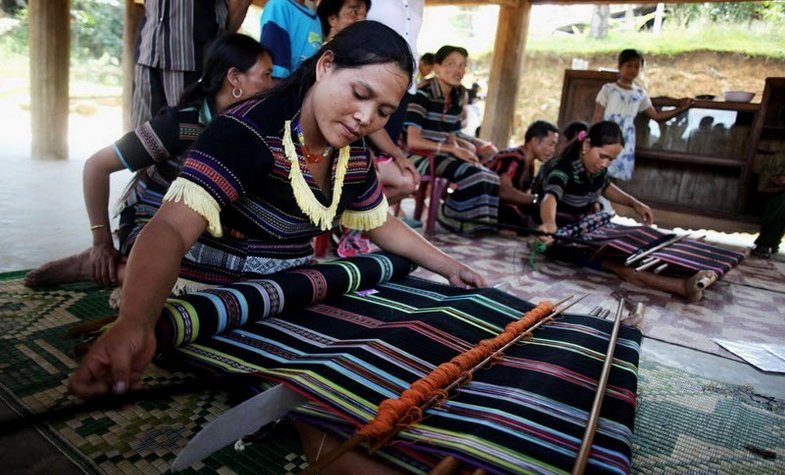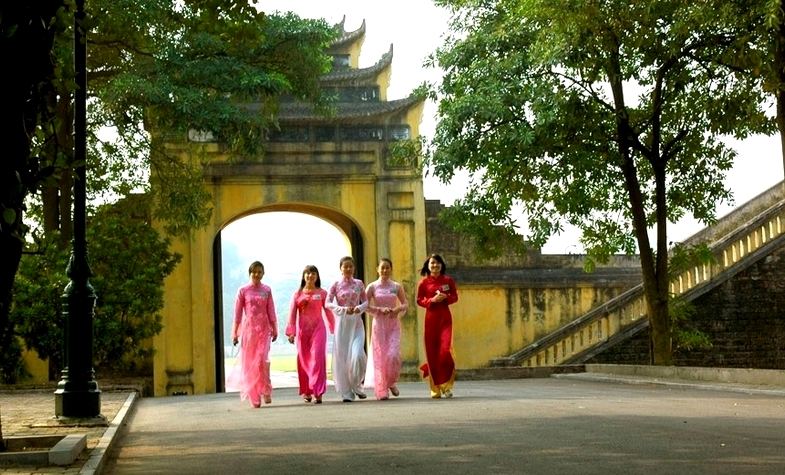Vietnamese literature: both oral and written, created largely by Vietnamese-speaking people, although Francophone Vietnamese and English-speaking Vietnamese authors in Australia and the United States are counted by many critics as part of the national works of literature. For much of the country’s history, Vietnam was dominated by China and as a result, much of the written work during this period was written in Classical Chinese. Chu nom, created around the 10th century, allowed writers to compose in Vietnamese using modified Chinese characters. Although regarded as inferior to the Chinese, it gradually grew in prestige. It flourished in the 18th century when many notable Vietnamese writers and poets composed their works in Chu nom and when it briefly became the official written script. While the Quoc Ngu script was created in the 17th century, it had not become popular outside of priest groups until the early 20th century, when the French colonial administration authorized its use in French Indochina. By the mid-20th century, virtually all Vietnamese works of literature were composed in Quoc Ngu script
Some defining Vietnamese works of literature, which have become world-famous include Truyen Kieu (The Tale of Kieu) by Nguyen Du and Luc Van Tien by Nguyen Dinh Chieu.
In Vietnamese modern prose, some authors could emulate whomever in the world, namely, Nguyen Cong Hoan, Vu Trong Phung, Ngo Tat To, Nguyen Hong, Nguyen Tuan, and Nam Cao. They were joined by excellent poets: Xuan Dieu, Huy Can, Han Mac Tu, and Nguyen Binh. Regrettably, their great works that faithfully reflected the country and the times have yet to appear.

Poetry: Legendary female poetess Ho Xuan Huong (born at the end of the 18th century) composed much of her poetry in Chu Nom, and most of it has been translated into Quoc Ngu for modern Vietnamese. Her poetry continues to be widely popular. Other poets such as the famous Mandarin official Duong Khue had some of his poetry adapted into songs that are still famous today, such as the Ca Tru-genre song "Hong Hong Tuyet Tuyet".
Many Vietnamese poems, along with folk "literature" in general, tends to be much more of an oral tradition - as literacy (as it is defined today) in the past was limited mostly to scholars and the elite
Vietnamese art has changed a lot during its long and rich history. The earliest samples of which date back to the Stone Age around 8,000 BCE. During the era of Chinese domination that started in the 2nd century BC, Vietnamese art undeniably absorbed many Chinese influences, which continued even after the following independence from China in the 10th century AD. However, Vietnamese art has always retained many distinctively Vietnamese characteristics.
By the 19th century, the influence of French art took hold in Vietnam, having a large hand in the birth of modern Vietnamese art.
Neolithic art
Terracotta pieces are used to imprint decoration patterns on cloth.
Pottery dating to the Stone Age (c. 8000 BCE) has been found in Bac Son, Vietnam. This pottery was made from clay, and in its beginnings was largely basic and lacking any artistic flare. Moving into the Neolithic era, however, Vietnamese pottery and ceramics started to develop rapidly, showing signs of decor.

Bronze Age art
The highly developed Dong Son culture that flourished in North Vietnam (from about 1000 BC to the 4th century BC) was the civilization responsible for the world-famous Dong Son drums, a product of their advanced bronze-casting skills.
These drums give us an important peek into early Vietnamese life. They were elaborately decorated with geometric patterns, and most importantly depicted scenes of everyday life such as farming, warriors donning feather headdresses, construction of ships, musicians, etc.
Archaeological evidence from this period also shows that people in the area had long been weaving cloth. Many of the people depicted on the drums are shown as wearing elaborate clothing.
Chinese domination from 111 BC to 939 AD
During the ten centuries of rule by the Chinese, Vietnamese began to apply newly learned Chinese techniques to art and specifically ceramics, however, this was in conjunction with the continued production of art based on native methods; this is proven by an excavation of Chinese tombs in the area.
From the Ngo to Tran Dynasty
Vietnamese art and ceramics during this period of independence (approximately the 10th to 15th centuries) flourished. The ceramics from this period were thought to have been largely influenced by both ancient native styles and the Tang and later Song dynasty's art, including applying the "three colors" concept to its ceramics. Chinese-influenced philosophies adopted by the Vietnamese such as Confucianism, Mahayana Buddhism, and Taoism all had a lasting impression on Vietnamese art. Some also claim there are small traces of Cham influences to be found as well.
The Lý Dynasty, beginning in the 11th century is viewed specifically as the golden age of Vietnamese art, and its ceramics became famous across East and Southeast Asia. The Lý Dynasty also saw the construction of many of Vietnam's landmark structures, including the Temple of Literature, One-pillar pagoda, and Quynh Lam pagoda. The Trần Dynasty that immediately followed in the 13th century saw a more subdued approach to art.
Le Dynasty
The fourth Chinese domination of Vietnam was quite short-lived, lasting only about 2 decades but it caused a huge loss for Vietnamese culture. Many if not most classical Vietnamese books were burnt, and thus much documentation of the era of independence was lost. It is said that a more extreme than-ever process of sinicization was enforced, and countless Vietnamese resources and goods were removed and taken to China. After the Victory and Liberation, the Country under the rule of the Le Dynasty was rebuilt. During the Le Dynasty, Vietnamese culture reached its peak with lots of architectural and literary works which have been recognized for their outstanding value.
Nguyen Dynasty
The Nguyen Dynasty, the last ruling dynasty of Vietnam, saw a renewed interest in ceramics and porcelain art. Imperial courts across Asia imported Vietnamese ceramics.
Despite how highly developed the performing arts (such as imperial court music and dance) became during the Nguyễn Dynasty, some view other fields of arts as beginning to decline during the latter part of the Nguyen Dynasty.

Modern Art
Beginning in the 19th century, French artistic influences spread into Vietnam. In the early 20th century, the École Supérieure des Beaux-Arts de l’Indochine (Indochina College of Arts) was founded to teach European methods and exercised influence mostly in the larger cities, such as Hanoi and Ho Chi Minh City.
Travel restrictions imposed on the Vietnamese during France's 80-year rule of Vietnam and the long period of war for national independence meant that very few Vietnamese artists were able to train or work outside of Vietnam. A small number of artists from well-to-do backgrounds had the opportunity to go to France and make their careers there for the most part. Examples include Le Thi Luu, Le Pho, Mai Trung Thu, Le Van De, Le Ba Dang and Pham Tang.
Modern Vietnamese artists began to utilize French techniques with many traditional mediums such as silk, lacquer, etc., thus creating a unique blend of eastern and western elements.
Nowadays, besides working with traditional material like oil, acrylic, lacquer on wood, the young generation of Vietnamese art becomes very active in involving in different forms of arts, such as installation, performance, video art... and many of them have got international recognition for their artworks and have exhibitions worldwide.
Architecture
It is believed that in prehistoric times, Vietnamese people lived in stilt-houses, as depicted on the bronze Dong Son drums. Similar kinds of houses can still be found in Vietnam today.
When Chinese influence permeated Vietnam, Chinese architecture had a large influence on the basic structure of many types of Vietnamese buildings, mostly pagodas and temples, communal houses, houses of scholar-bureaucrats, aristocracy, and imperial palaces and quarters. Nevertheless, these structures combined both Chinese influences and native style; Vietnamese architecture is generally much more ornamental and florid than Chinese architecture, using different colours and materials suited to the environment.
With the French colonization of Vietnam in the 19th century, many French-styled buildings were constructed, including villas, government buildings, opera houses, etc. Many of these buildings still stand in Vietnam and are one of the clearest remnants of the French colonial legacy.
Some of Vietnam's most notable architectural structures include:
The Temple of Literature or (Văn Miếu): Located in Hanoi, North Vietnam. It was constructed during the Lý Dynasty and dedicated to Confucius and his disciples. It is a fine example of the elegance of Lý Dynasty architecture, although much of it needs repairing. The Temple of Literature is a series of courtyards, buildings and pavilions, the centre of which houses the famed stone steles. These steles are placed on top of stone turtles and are inscribed with the names of doctorate candidates successful at the Imperial examination. Also within the temple lies the "Quốc Tử Giám" or National University, which functioned for approximately 700 years, from 1076 to 1779.
Imperial City and surrounds, Huế: During the reign of the Nguyen Dynasty, a new imperial citadel in Hue was built, largely based on the Chinese Forbidden City in Beijing, and also called the Purple forbidden city. However, it still employed many Vietnamese characteristics in its design. Other imperial structures built much later, such as the outlying tomb of Khai Định, used French architectural elements as well. The tomb of Minh Mang is often considered one of the most beautiful structures in the Huế area, situated near a vast lotus pond, its construction was not completed until after Minh Mạng's death.

The citadel formerly sprawled a vast estate, but during subsequent wars and conflicts, much of it has been destroyed and later turned into rice paddies. The remaining areas are currently being restored by UNESCO.
One Pillar Pagoda: The one pillar pagoda is one of the most ancient structures of Hanoi, its design credited to Emperor Lý Thái Tổ. The story goes that the emperor had longed for a son, and one daydreamed that the Goddess of Mercy was sitting on a lotus flower offering him a son. In gratitude and reverence of his dream, he ordered the construction of a small pagoda in the form of a lotus, overlooking a pond. The pagoda has been rebuilt countlessly due to it being destroyed and burnt in wars by opponents.
Perfume Pagoda and the surrounding area: The Perfume Pagoda is an ancient structure in Ha Tay province, located specifically in Perfume mountain, and is the site for a yearly festival attended by hundreds of thousands of Vietnamese. Most people reach the pagoda by taking an hour boat ride across the scenic river (passing the countryside scattered with smaller pagodas) before reaching the Perfume Pagoda itself. Inside are a series of temples and structures, and a grotto with stairs leading to two paths: "Heaven's Gate" and "Hell's gate". Descending deep into the grotto one finds the Inner temple.
The beauty of the Perfume Pagoda and the surrounding area has served as the subject in many Vietnamese poems.
Calligraphy
Calligraphy has had a long history in Vietnam, previously using Chinese characters along with Chu Nom. However, most modern Vietnamese calligraphy instead uses the Roman-character based Quoc Ngu, which has proven to be very popular.
In the past, with literacy in the old character-based writing systems of Vietnam being restricted to scholars and elites, calligraphy nevertheless still played an important part in Vietnamese life. On special occasions such as the Lunar New Year, people would go to the village teacher or scholar to make them a calligraphy hanging (often poetry, folk sayings or even single words). People who could not read or write also often commissioned scholars to write prayers which they would burn at temple shrines.
Silk painting
Vietnamese silk painting is one of the most popular forms of art in Vietnam, favoured for the mystical atmosphere that can be achieved with the medium. During the 19th and 20th centuries, French influence was absorbed into Vietnamese art and the liberal and modern use of colour especially began to differentiate Vietnamese silk paintings from their Chinese or Japanese counterparts.
Vietnamese silk paintings typically showcase the countryside, landscapes, pagodas, historical events or scenes of daily life.
Woodblock prints
Folk art with a long history in Vietnam, Vietnamese woodblock prints have reached a level of popularity outside of Vietnam. Organic materials are used to make the paint, which is applied to wood and pressed on paper. The process is repeated with different colours.

Music
Vietnamese music varies slightly in the three regions: Bac or North, Trung or Central, and Nam or South. Northern classical music is Vietnam's oldest and is traditionally more formal. Vietnamese classical music can be traced to the Mongol invasions when the Vietnamese captured a Chinese opera troupe. Central classical music shows the influences of Champa culture with its melancholic melodies. Southern music exudes a lively laissez-faire attitude.
Vietnam has some 50 national music instruments, in which the set of percussion instruments is the most popular, diverse and long-lasting such as Trong dong (copper drums), Cong Chieng (gongs), Dan da (lithophone), Dan to rung... The set of blowing instruments is represented by flutes and pan-pipes, while the set of string instruments is specified by dan bau and dan day.
The Vietnamese folksongs are rich in forms and melodies of regions across the country, ranging from reciting poems, lullaby, chanty to hat quan ho, trong quan, xoan, dum, vi giam, ca Hue, bai choi, ly. Apart from this, there are also other forms like hat xam, chau van and ca tru.
Two of the most widely known genres are:
Imperial Court music: When referring specifically to the "Nha nhạc" form it includes court music from the Tran Dynasty on to the Nguyen Dynasty. It is an elaborate form of music that features an extensive array of musicians and dancers, dressed in extravagant costumes. It was an integral part of the rituals of the Imperial court.
Ca tru: An ancient form of chamber music that originated in the imperial court. It gradually came to be associated with a geisha-type of entertainment where talented female musicians entertained rich and powerful men, often scholars and bureaucrats who most enjoyed the genre. It was condemned in the 20th century by the government, being tied falsely with prostitution, but recently it has seen a revival as appreciation for its cultural significance has grown. Ca trù has been recognized by UNESCO as a Masterpiece of the Oral and Intangible Heritage of Humanity since 2005.
In the 20th century, in contact with the Western culture, especially after the national independence, many new categories of arts like plays, photography, cinemas, and modern art had taken shape and developed strongly, obtaining huge achievements with the contents reflecting the social and revolutionary realities. Up to 1997, there have been 44 people operating in cultural and artistic fields honored with the Ho Chi Minh Award, 130 others conferred with People's Artist Honor, and 1011 people awarded with the Excellent Artist Honor. At the start of 1997, there were 191 professional artistic organizations and 26 film studios (including central and local ones). There have been 28 movies, 49 scientific and documentary films receiving international motion picture awards in many countries.
Traditional theatre genres include:
Cai Luong: A kind of modern folk opera originating in South Vietnam, which utilizes extensive vibrato techniques. It remains very popular in modern Vietnam when compared to other folk styles.
Hat cheo: The most mainstream of theatre/music forms in the past, enjoyed widely by the public rather than the more obscure Ca trù which was favoured more by scholars and elites.
Hat tuong: A theatre form strongly influenced by Chinese opera, it transitioned from being entertainment for the royal court to travelling troupes who performed for commoners and peasants, featuring many well-known stock characters.
Traditional dance
Vietnam has 54 different ethnicities, each with its traditional dance. Among the ethnic Vietnamese majority, there are several traditional dances performed widely at festivals and other special occasions, such as the lion dance.
In the imperial court, there also developed throughout the centuries a series of complex court dances which require great skill. Some of the more widely known are the imperial lantern dance, fan dance, and platter dance, among others.

Water puppetry
Water puppetry is a distinct Vietnamese art that had its origins in the 12th century. In water puppetry, a split-bamboo screen obscures puppets that stand in water and are manipulated using long poles hidden beneath the water. Epic storylines are played out with many different characters, often depicting traditional scenes of Vietnamese life. Despite nearly dying out in the 20th century, it has been saved by efforts of preservation and is now largely seen by tourists to Vietnam.
Clothing
In feudal Vietnam, clothing was one of the most important marks of social status and strict dress codes were enforced.
Commoners had a limited choice of similarly plain and simple clothes in everyday use, as well as being limited in the colours they were allowed to use. For a period, commoners were not allowed to wear clothes with dyes other than black, brown or white (except special occasions such as festivals), but in actuality, these rules could change often based upon the whims of the current ruler.
The Ao Tu Than or "four-part dress" is one such example of an ancient dress widely worn by commoner women, along with the Ao yem bodice which accompanied it. Peasants across the country also gradually came to wear silk pajama-like costumes, known as "Áo cánh" in the north and Ao ba ba in the south.
The headgear of peasants often included a plain piece of cloth wrapped around the head, or the popular Non La (conical hat). For footwear, peasants would often go barefoot, whereas sandals and shoes were reserved for the aristocracy and royalty.
Monarchs had the exclusive right to wear the colour gold, while nobles wore red or purple. Each member of the royal court had an assortment of different formal gowns they would wear at a particular ceremony, or for a particular occasion. The rules governing the fashion of the royal court could change dynasty by dynasty, thus the Costumes of the Vietnamese court were quite diverse.
The most popular and widely-recognized Vietnamese national costume is the Ao Dai. Áo Dài was once worn by both genders but today it is worn mainly by females, except for certain important traditional culture-related occasions where some men do wear it. Ao Dai is elegant and comfortable to wear. Áo Dài was likely derived in the 18th century or the royal court of Hue. White Ao dai is the required uniform for girls in many high schools across Vietnam. Some female office workers (e.g. receptionists, secretaries, tour guides) are also required to wear Ao Dai.
In daily life, the traditional Vietnamese styles are now replaced by Western styles. Traditional clothing is worn instead on special occasions, except the white Áo Dài commonly worn by high school girls in Vietnam.
Martial Arts
Vietnamese martial arts is highly developed from the country's very long history of warfare and attempts to defend itself from foreign occupation. Although most heavily influenced by Chinese martial arts, it has developed its own characteristics throughout the millennia in combination with other influences from its neighbors. Vietnamese martial arts is deeply spiritual due to the influence of Confucianism, Buddhism and Taoism, and is strongly reliant on the "Viet Vo Dao" (philosophy of Vietnamese martial arts). It is probably most famous for its scissor kicks.
The general Vietnamese term for martial arts is "Võ-Thuật." Some of the more popular include:
- Vovinam
- Vo Binh Dinh
- Quan Khi Dao
Vietnamese martial art remains relatively unknown in the world today when compared to its counterparts from China, Japan, Korea or Thailand. However, this is seeing a definite change as schools teaching various styles of Vietnamese martial arts are starting to pop up all over the world, notably in countries such as Spain.

